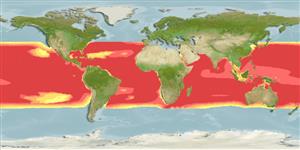Common names from other countries
>
Aulopiformes (Grinners) >
Omosudidae (Hammerjaws)
Etymology: Omosudis: Greek, omo = shoulder + Latin, sudis = esox, fish of the Rhine, cited by Plinius 9.15; it also means "stake" (Ref. 45335).
More on author: Günther.
Environment: milieu / climate zone / depth range / distribution range
Ecologia
marinhas batipelágico; intervalo de profundidade 0 - 4000 m (Ref. 38732), usually 100 - 1000 m (Ref. 7344). Deep-water; 40°N - 40°S
Worldwide in tropical and temperate waters. South China Sea and East China Sea (Ref.74511)
Tamanho / Peso / Idade
Maturity: Lm ? range ? - ? cm
Max length : 23.0 cm SL macho/indeterminado; (Ref. 4475); common length : 20.0 cm NG macho/indeterminado; (Ref. 5755)
Espinhos dorsais (total): 0; Raios dorsais moles (total): 9-12; Espinhos anais 0; Raios anais moles: 14 - 16. Brownish above, sides silvery, iridescent, with black peritoneum showing through (Ref. 7344).
Meso- and bathypelagic at 700-1830 m (Ref. 58302). Probably swift swimmers, which can avoid nets, captured singly or in small groups (Ref. 6692). Carnivorous, feed on squids and pelagic fishes (Ref. 6692). Oviparous and are synchronous hermaphrodites (Ref. 84733).
Life cycle and mating behavior
Maturidade | Reprodução | Desova | Ovos | Fecundidade | Larvas
Are synchronous hermaphrodites, gonads consist of clearly defined and well separated ovarian and testicular regions with no indication of sequential maturation of the sex products (Ref. 84733). Also Ref. 103751.
Post, A., 1984. Omosudidae. p. 496-497. In P.J.P. Whitehead, M.-L. Bauchot, J.-C. Hureau, J. Nielsen and E. Tortonese (eds.) Fishes of the north-eastern Atlantic and the Mediterranean. UNESCO, Paris. Vol. 1. (Ref. 6692)
Categoria na Lista Vermelha da IUCN (Ref. 130435)
CITES (Ref. 128078)
Not Evaluated
Ameaça para o homem
Harmless
Utilização humana
Pescarias: sem interesse
Mais informação
ReferênciasAquaculturaPerfil para aquaculturaEstirpesGenéticaElectrophoresesHereditariedadeDoençasProcessamentoMass conversion
Ferramentas
Relatórios especiais
Descarregue XML
Fontes da internet
Estimates based on models
Preferred temperature (Ref.
115969): 4.8 - 21.3, mean 10.5 (based on 2379 cells).
Phylogenetic diversity index (Ref.
82804): PD
50 = 1.5000 [Uniqueness, from 0.5 = low to 2.0 = high].
Bayesian length-weight: a=0.00389 (0.00180 - 0.00842), b=3.12 (2.94 - 3.30), in cm Total Length, based on all LWR estimates for this body shape (Ref.
93245).
Nível Trófico (Ref.
69278): 4.3 ±0.64 se; based on food items.
Resiliência (Ref.
120179): Médio, tempo mínimo de duplicação da população 1,4 - 4,4 anos (Assuming tm=2-4).
Fishing Vulnerability (Ref.
59153): Low vulnerability (18 of 100).
